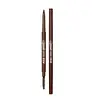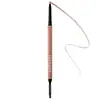What's inside
What's inside
 Key Ingredients
Key Ingredients

 Benefits
Benefits

No benefits
 Concerns
Concerns

 Ingredients Side-by-side
Ingredients Side-by-side

Polyethylene
AbrasiveCI 77499
Cosmetic ColorantMicrocrystalline Wax
Emulsion StabilisingCI 77891
Cosmetic ColorantPolyglyceryl-2 Triisostearate
EmulsifyingZinc Stearate
Cosmetic ColorantHydrogenated Coco-Glycerides
EmollientC12-15 Alkyl Ethylhexanoate
EmollientCI 77492
Cosmetic ColorantC20-40 Alcohols
EmulsifyingCI 77491
Cosmetic ColorantMica
Cosmetic ColorantSynthetic Beeswax
Emulsion StabilisingSynthetic Wax
AbrasiveDipentaerythrityl Hexahydroxystearate/Hexastearate/Hexarosinate
Skin ConditioningStearic Acid
CleansingSorbitan Tristearate
EmulsifyingDimethicone
EmollientGlyceryl Caprylate
EmollientCaprylyl Glycol
EmollientPolyethylene, CI 77499, Microcrystalline Wax, CI 77891, Polyglyceryl-2 Triisostearate, Zinc Stearate, Hydrogenated Coco-Glycerides, C12-15 Alkyl Ethylhexanoate, CI 77492, C20-40 Alcohols, CI 77491, Mica, Synthetic Beeswax, Synthetic Wax, Dipentaerythrityl Hexahydroxystearate/Hexastearate/Hexarosinate, Stearic Acid, Sorbitan Tristearate, Dimethicone, Glyceryl Caprylate, Caprylyl Glycol
Diisostearyl Malate
EmollientTriethylhexanoin
MaskingCI 77891
Cosmetic ColorantC20-40 Acid
CleansingC20-40 Alcohols
EmulsifyingMica
Cosmetic ColorantPolyethylene
AbrasiveSynthetic Wax
AbrasiveCI 77492
Cosmetic ColorantGlyceryl Behenate/Eicosadioate
EmollientEthylene/Propylene Copolymer
AbrasiveCI 77499
Cosmetic ColorantEthylcellulose
CI 77491
Cosmetic ColorantBoron Nitride
AbsorbentVp/Eicosene Copolymer
Tocopherol
AntioxidantAscorbyl Palmitate
Antioxidant
 Reviews
Reviews

Ingredients Explained
These ingredients are found in both products.
Ingredients higher up in an ingredient list are typically present in a larger amount.
We don't have a description for C20-40 Alcohols yet.
Ci 77491 is also hydrated iron III oxide. It's sole purpose is to give a red/pink hue to products.
Iron III oxides are classified as inorganic chemicals for coloring.
Synthetically created Ci 77491 is considered safer than those naturally found. This is because the synthetically created version may contain less impurities. Iron oxides are generally non-toxic and non-allergenic.
Learn more about CI 77491Ci 77492 is also hydrated iron III oxide. It's sole purpose is to give a yellow hue to products.
Iron III oxides are classified as inorganic chemicals for coloring.
Synthetically created Ci 77492 is considered safer than those naturally found. This is because the synthetically created version may contain less impurities. Iron oxides are generally non-toxic and non-allergenic.
Learn more about CI 77492Ci 77499 is also hydrated iron III oxide. It is created from mixing red and black iron oxides. This helps give shades of darkness to a product.
Iron III oxides are classified as inorganic chemicals for coloring.
Ci 77891 is a white pigment from Titanium dioxide. It is naturally found in minerals such as rutile and ilmenite.
It's main function is to add a white color to cosmetics. It can also be mixed with other colors to create different shades.
Ci 77891 is commonly found in sunscreens due to its ability to block UV rays.
Learn more about CI 77891Mica is a naturally occurring mineral used to add shimmer and color in cosmetics. It can also help improve the texture of a product or give it an opaque, white/silver color.
Serecite is the name for very fine but ragged grains of mica.
This ingredient is often coated with metal oxides like titanium dioxide. Trace amounts of heavy metals may be found in mica, but these metals are not harmful in our personal products.
Mica has been used since prehistoric times throughout the world. Ancient Egyptian, Indian, Greek, Roman, Aztec, and Chinese civilizations have used mica.
Learn more about MicaPolyethylene is a synthetic ingredient that helps the skin retain moisture. It is a polymer.
It is also typically used within product formulations to help bind solid ingredients together and thicken oil-based ingredients. When added to balms and emulsions, it helps increase the melting point temperature.
Synthetic Wax is created from fossil fuels such as natural gas. It is used to enhance texture, adjust pH, and as an occlusive.
It may also be used as an abrasive ingredient to exfoliate the skin.
Synthetic Wax may not be fungal acne safe.
Learn more about Synthetic Wax